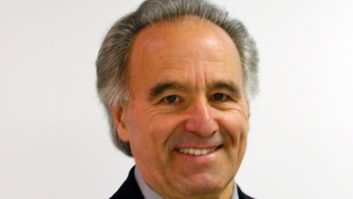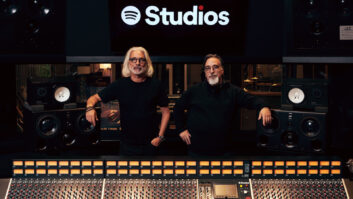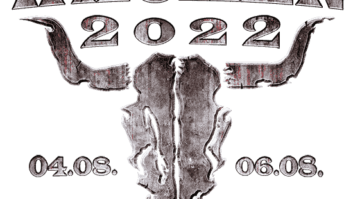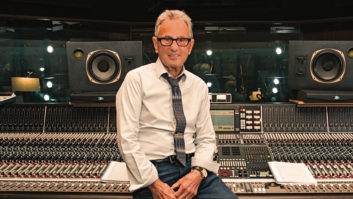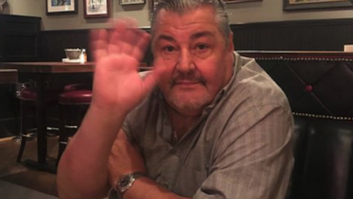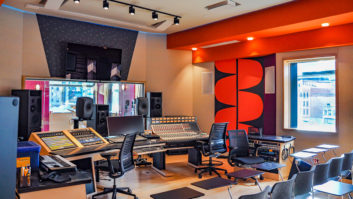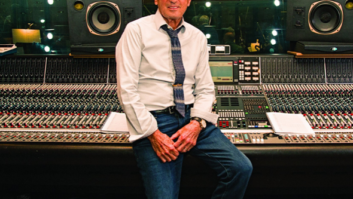The extraordinary success of Norah Jones’ Come Away With Me, her first full-length album for Blue Note, has taken many people by surprise, not least Norah Jones herself. Until early this year, the 22-year-old singer/ songwriter/pianist was accustomed to playing small jazz clubs in New York, and her typical audience numbered fewer than 100. Now, Jones’ appearances at clubs and theaters sell out immediately, and by mid-summer, she had experienced the thrill and fear of playing to thousands of Dave Matthews Band fans in a football stadium.
“We got to England, and the album was Number 70,” recalls production manager and FOH engineer Lee Moro, who has been touring with Jones and her bass/drums/guitar trio since last March. “By the time we left three weeks later, the record was at Number 7 and had sold 200,000 copies in Britain alone.”
FROM JAZZ CLUBS TO FOOTBALL STADIUMS
As Moro describes it, his biggest challenge has been convincing Jones that the P.A. needs to be loud enough to carry to the back rows. “The Dave Matthews dates were pretty tough,” says Moro. “You have to cover 25,000 people in a football stadium, which is a bit different from a little jazz club or a theater, where it’s fairly controlled.”
Moro is used to big gigs and large crowds; before getting hired for the Norah Jones tour, he was out on tour with Canadian band the Tea Party, who were supporting Ozzy Osbourne. But Jones, unlike Moro, does not have more than a dozen years of touring experience behind her. “It’s all been happening extremely fast for her,” says Moro. “In three months, she sold over a million records worldwide and went from playing to 50 people for brunch in a New York club to going to Europe and selling out 1,500-seaters.”
Mix caught up with the Norah Jones phenomenon in early August at Bimbo’s 365 Club in San Francisco, where both shows were sellouts. Moro brought in legendary lighting director Stan Crocker to make the most of Bimbo’s intimate 600-seat supper club ambience. The Phil Edwards Recording truck was also on hand, recording both nights’ performances, which gave Moro access to a pair of Neumann U87s for the piano.
“I always use three or four channels for the piano, and I generally use whatever the house has,” explains Moro. “I just used the Shure VP88 stereo mic in Las Vegas, and that was great. I always have the lid all the way closed, so I had the VP88 taped across the bars about halfway up.”
PIANO SOUND INCLUDES EVERYTHING
Whatever the piano mic, Moro has to cope with leakage. “I’ve tried everything — 91s taped to the lid, C-ducer tapes, you name it,” he says. “Norah plays really, really soft and has the monitors really, really loud, so any mic you put in there is going to pick up her vocal from the monitors. And no matter how big the stage, the setup is pretty tight and you get tons of drums through the piano. The bass is also right behind, so there’s a lot of leakage from that, too. I have a Barcus Berry pickup in the piano for the monitors and sometimes I need it out front.”
The rest of the trio setup is straightforward: Guitarist Adam Levy plays his two electrics and an acoustic through a small amp that Moro mikes with a Shure SM57. “It just seems to work with his style,” notes Moro. “I’ve tried a lot of large-diaphragm stuff, but his rhythm style is really quiet and his solo stuff has a 2 to 4k peak that’s deathly — I can’t even compress it — so a 57 is the safest bet.”
Moro’s mic selection generally depends on what is available at the venue. At Bimbo’s, where he had access to both the house and Phil Edwards Recording mic inventories, Moro was using a Sennheiser 602 on kick drum. “I usually use the Shure Beta 52, which is a nice, round mic that’s really good for jazzy stuff, but I’m really happy with the 602 — the Dave Matthews guy was using it,” Moro says. For the rest of drummer Andrew Border’s kit, Moro picked Shure 56As on the toms, an SM57 on the snare, an SM81 on the hi-hat and Audio-Technica 4050s for overheads. “They’re nice and wide, and I use a lot of overheads on this show,” Moro comments. For Lee Alexander’s acoustic bass, he took a DI from a pickup under the bridge and put a Beyer 88 on the amp.
Norah Jones’ two vocal mics — she sings a few songs at a Wurlitzer electric piano — are Neumann KMS 105s. “A 58 will always work, but once I got a little bit of money in the budget, I got the Neumanns,” says Moro. “I didn’t have them in Europe, but I decided I really needed them.” Tour manager Daru joins guitarist Levy to sing backup on two songs, one of them a heart-rending performance of The Band’s “It Makes No Difference.”
TUBE COMPRESSORS ON VOCALS
Moro’s input list calls for 20 to 25 inputs, which is not usually a problem, though he occasionally has to rent in a board and sound system. “A lot of playhouses have just a pair of speakers on sticks, so I’ve had to rent in situations like that. I’ve seen everything from a Meyer or Turbosound rig to some homemade system that sounds pretty good,” he says. “I also make sure I can get a couple of tube compressors at FOH.” At Bimbo’s, which has a comprehensive collection of outboard processors, Moro was happy to have Summit compressors for the lead vocals and assigned BSS compressors to the piano and bass, with dbx units on the kick, snare and Wurlitzer. Moro says he typically uses very little compression on the instruments, but he likes to have the protection.
Bimbo’s has recently upgraded its main sound system to a compact Nexo Alpha rig, supplemented with Meyer Sound UPAs for the back of the two-section room. The FOH console is a Midas XL22 — “Midas is my favorite,” comments Moro — and monitors are mixed on a Ramsa 850. For reverbs, Moro is partial to high-end TC Electronic or Lexicon models, but also speaks highly of the less-expensive TC M-One.
Though Jones relied on wedge monitors at Bimbo’s, she has also used in-ear monitors when appearing on a larger stage, such as when she did five dates opening for the Indigo Girls earlier in the tour. “Part of my job is to help her get a feeling of what it’s like to play really big places,” says Moro. “Before March, she’d only done 100-seaters and little jazz clubs, and she would never hear the P.A. because there was no P.A. to speak of. On this tour, on the bigger gigs, she would hear the room and wasn’t used to it, so she felt the house system was way too loud.” Moro now carries a Shure PSM 600 in-ear monitor system for Jones, though he admits that the standard E-1 rubber molds provide little isolation.
OPENING ACT BLUES
As well as unfamiliar surroundings, Jones has also had to cope with the perennial problem as an opening act: People who are finding their seats during the opening numbers. “For the Dave Matthews shows, the lawn was general admission, so that filled up right away,” says Moro. “But the front 6,000 seats were all reserved, and a lot of those ticket-holders were still in the parking lot — they’re Dave Matthews fans. So she played to this moat of empty seats for at least the first two songs while people were filtering in, which was quite a distraction for her. And at some of these outdoor shows, there’s an amusement park right next door, so you can look out and see roller coasters and hear kids screaming. She was used to a pretty controlled environment. But her record sales spiked drastically after the Dave Matthews shows, so she did well.”
Norah Jones also did well at Bimbo’s, where the audience sat attentively throughout the 20-song set, which included some new songs and a few well-chosen covers: Kris Kristofferson’s “Help Me Make It Through the Night,” Mose Allison’s “Everybody’s Cryin’ Mercy,” and “Bessie Smith,” another song from The Band’s catalog. As Jones explained to the audience, she and her band have become habituated to watching The Band’s The Last Waltz on the tour bus.
Quite a lot of Jones’ life is spent on the bus these days. “We’ve been touring since May, and she could go on forever right now; there are so many territories that want her,” says Moro. At present, tour dates are scheduled through next spring, when Jones will take a break to record her next album. If that record comes anywhere close to matching the runaway success of Come Away With Me, Jones is likely to be a fixture on the concert scene for many years to come.
Chris Michie is a Mix technical editor.
